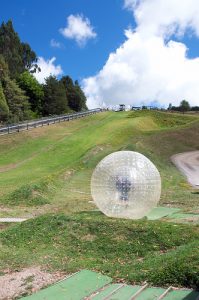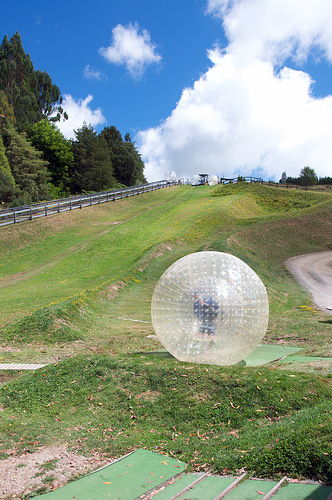 Straight out of New Zealand – home of nude rugby – comes the latest transportation sensation that’s sweeping the nation: globe riding. The sport came to be in 1994, when Andrew Akers and Dwane van der Sluis invented a giant inflatable ball that people could climb inside of, which they initially intended to use for walking on water. However, they soon discovered how much fun the balls were to just roll around in on land, and started a company to begin marketing the product – which they deemed a “Zorb” – to the public as a sport.
Straight out of New Zealand – home of nude rugby – comes the latest transportation sensation that’s sweeping the nation: globe riding. The sport came to be in 1994, when Andrew Akers and Dwane van der Sluis invented a giant inflatable ball that people could climb inside of, which they initially intended to use for walking on water. However, they soon discovered how much fun the balls were to just roll around in on land, and started a company to begin marketing the product – which they deemed a “Zorb” – to the public as a sport.
Andrew Akers and his brother David opened the first official Zorbing site in Rotura, New Zealand in 1997. In 2006, the pair left Zorb after becoming “frustrated by an increasingly corporate culture imposed by [the] new regime controlling the company” and started a new one marketing the same service and product, which they deemed OGO, according to OGO’s website.
The ball itself is composed of two spheres, an inflatable outer one and a hollow inner one. The air contained in the outer sphere acts as a cushion for the rider, absorbing the shock as the ball travels over bumps. Both spheres are made of soft, pliable plastic, and are connected to each other by numerous tiny ropes, all attached by hand. According to OGO’s website, the ball is “constructed from over 100 square metres (300 square feet) of plastic, more than 1,000 little plastic anchors, about 600 multi-coloured strings and endless hours of welding, glueing, and tieing combined with sweat, tears, and billions of teensy little kisses,” and stands at 3 metres (11 feet) high.
There are two types of globes offered by both companies: harnessed and non-harnessed. Harnessed riders are strapped into the globe, so they are immobile as it rolls. Non-harnessed globes allow their riders to freely move inside the globes, but there is a twist – water is added. On their website, Zorb advertises a cold water-filled globe as an excellent hangover treatment. The environments that riders roll across are specially designed to enhance the experience, offering all of the hills, valleys and ramps necessary to ensure an exciting ride.
As a kid, I used to lose my lunch by simply spinning a few times in a wheely chair, so I immediately wondered: do participants ever… you know… vomit inside of the orbs? Conveniently, this topic was addressed on Zorb’s website, as it is apparently one of their most frequently asked questions. Surprisingly, they claim that none of the hundreds of thousands of riders that have passed through their grounds have ever vomited because of the ball.
The balls have had immense popularity worldwide – and not just for riding in. Zorbs are one of the symbols to be used in the 2014 Sochi Winter Olympics in Russia. Dmitry Chernyshenko, president of the Sochi 2014 Olympic organizing committee, explained to the New Zealand herald that “The transparency of Zorbs… reflect the open, accessible and inclusive society that Sochi 2014 Games is helping to build.”
The balls have also been requested for NASA research on Mars landings – which Andrew Akers initially thought was a joke – and have been used in Seaworld shows, on the reality television show The Amazing Race, and in musician Peter Gabriel’s 2003 “Growing Up Live” tour – where he performed onstage from inside a ball. The term “Zorbing” is even included in the Oxford English Dictionary, and there are two Guinness world records related to the sport (one for the longest ride and one for the fastest).
The nearest place to go globe riding is currently Canada Olympic Park in Calgary, though there is also an OGO site at the Horseshoe Resort in Barrie, Ontario. Unfortunately, participants must be able to reach 5’6” and must weigh less than 250 pounds. Additionally, they offer only harnessed rides.
Official Zorb and OGO balls cannot be purchased by the public, due to the imminent danger of veering off into fences, people, and buses (all of which have actually happened during testing) but many companies make imitations for personal use. So, is globe riding destined to become the future of personal transportation as we know it? We can only hope.


